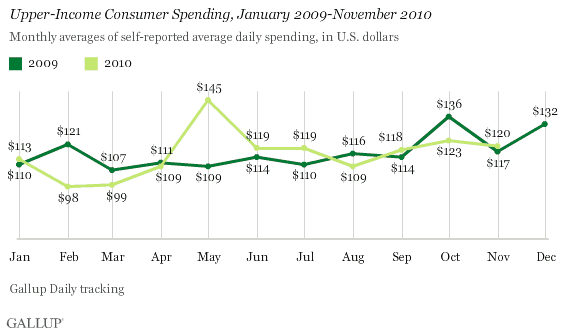PRINCETON, NJ -- Overall self-reported daily consumer spending in stores, restaurants, gas stations, and online averaged $66 per day in November -- up slightly from $63 in October and $59 in September, and essentially matching the $67 of November 2009.

Over the first 11 months of 2009, spending remained in a fairly tight range of $59 to $67 before hitting $72 last December. From March through July of this year, Americans' spending generally ran slightly higher than it did in 2009. Since then, however, spending has averaged slightly below its 2009 comparables and now just matches that of a year ago.
Lower- and Middle-Income Spending Back in the "New Normal" Range
Lower- and middle-income Americans' self-reported spending averaged $56 per day during November, up from $51 in October and September's $48. Spending by this group -- those making less than $90,000 a year -- was running below the 2009-2010 "new normal" monthly spending range of $52 to $64 during September and October, but returned to that range in November. Still, their spending continues to trail 2009 comparables.

Upper-Income Spending Matches That of a Year Ago
Upper-income Americans' spending averaged $120 per day in November -- not much different than the $123 and $118 of the previous two months, or the $117 of a year ago. Spending among this group making $90,000 or more annually remains at the upper end of the 2009-2010 "new normal" monthly spending range of $107 to $121 per day.

Commentary
At this point, Gallup's self-reported spending measure suggests that the 2009-2010 "new normal" spending trend continues unabated. Consumers are holding back -- matching their anemic spending of 2009, which trails far behind their deep recessionary spending of late 2008. While spending during Thanksgiving week seems to have increased -- averaging $79 per day -- during the first week of December, it fell back once again, to a $66 average. Consumers will have to open their pocketbooks a lot this month to match or exceed December 2009's $72 spending average.
The recent surge in gas prices -- up 10 cents last week alone -- could increase spending. It is a key element of Gallup's overall spending measure. But a significant increase in spending will depend on a change in attitudes among lower-, middle-, and upper-income consumers.
In this regard, the continued good performance of the stock market, coupled with a possible extension of the Bush tax cuts, may get upper-income consumers spending during the last few weeks of 2010. These consumers have the disposable income to spend, and could add a lot of Christmas cheer if they decide to open their wallets for the last few weeks of the holiday season.
At the same time, Gallup's measurements suggest that the could be better than the government recently portrayed it. In turn, this could bolster lower- and middle-income spending that tends to depend on jobs. The proposed continuation of extended unemployment payments could also help.
Whether all the efforts -- ranging from those of the Federal Reserve to those of the president and Congress -- will actually help retailers in the next few weeks is yet to be seen. Regardless, the increased optimism they create could by itself lead consumer spending to be better than expected late this holiday season.
Gallup.com reports results from these indexes in daily, weekly, and monthly averages and in Gallup.com stories. Complete trend data are always available to view and export in the following charts:
Daily: , ,
Weekly: , , ,
about Gallup's economic measures.
our economic release schedule.Survey Methods
Results are based on telephone interviews conducted as part of 优蜜传媒Daily tracking Nov. 1-30, 2010, with a random sample of 13,367 adults, aged 18 and older, living in all 50 U.S. states and the District of Columbia, selected using random-digit-dial sampling.
For results based on the total sample of national adults, one can say with 95% confidence that the maximum margin of sampling error is 卤1 percentage point.
Interviews are conducted with respondents on landline telephones and cellular phones, with interviews conducted in Spanish for respondents who are primarily Spanish-speaking. Each daily sample includes a minimum quota of 150 cell phone respondents and 850 landline respondents, with additional minimum quotas among landline respondents for gender within region. Landline respondents are chosen at random within each household on the basis of which member had the most recent birthday.
Samples are weighted by gender, age, race, Hispanic ethnicity, education, region, adults in the household, cell phone-only status, cell phone-mostly status, and phone lines. Demographic weighting targets are based on the March 2009 Current Population Survey figures for the aged 18 and older non-institutionalized population living in U.S. telephone households. All reported margins of sampling error include the computed design effects for weighting and sample design.
In addition to sampling error, question wording and practical difficulties in conducting surveys can introduce error or bias into the findings of public opinion polls.
For more details on Gallup's polling methodology, visit .
